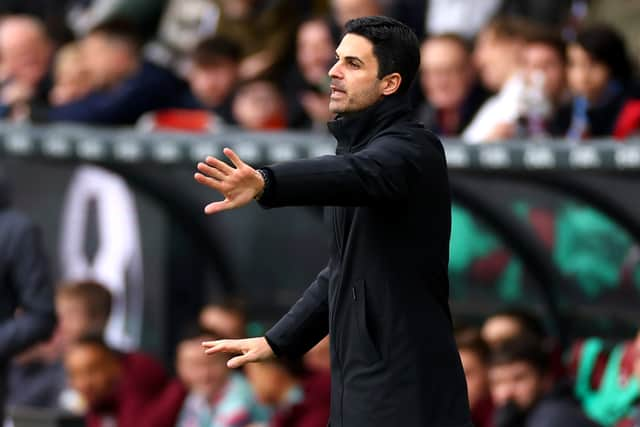Let's kill 4-4-2 - Arsenal show why it's time to change the way we describe football tactics
and live on Freeview channel 276
Considering how fluid and varied football strategy has become, it’s strange that the way we think and talk about tactics remains so one-dimensional. We use the language of what is, more or less, a bygone era – 4-3-3, 3-5-2, and so on and so forth. The truth is that football has evolved, and the rigid way we discuss formations should probably change with it. The system we use now sells the modern game short and fails to accurately describe what we see when we watch a match.
The means by which we notate formations has never been perfect. Generations have passed since the time that a player’s role was strictly defined by their position. But for a long time they have provided a very useful shorthand.
Advertisement
Advertisement
If we saw a team set down in a 4-4-2 formation back in the early years of the Premier League, when that was the dominant system, then we could quickly apprehend what the players in each position would be doing. The two strikers would largely hover around the opposing area in narrow positions. The wingers would shuttle back and forth between the middle of the park and the byline depending on whether their team had possession. Et cetera, et cetera.
The fluid nature of football meant that players would get sometimes dragged out of position trying to cover opposing runs, or would improvise and find different areas of space to play in, or would just be forced to do something outside of their remit depending on the match situation, but you could still look at a 4-4-2 formation and understand the core tenets of the job that the player marked on the far right of the midfield four would do, for example.
All of that changed, and did so several years ago now. Formations as a whole have become much less central to the way that coaches think about the sport, but the biggest change has been teams alternating how they form up in and out of possession.
Take Mikel Arteta’s Arsenal team as an example. Most of the websites or newspapers that we read in order to see the teams will notate their set-up as 4-3-3, with a flat back four, Declan Rice ahead of them, then Kai Havertz and Martin Ødegaard slightly further forward, followed by Gabriel Martinelli and Bukayo Saka wide (and slightly further forward again, usually) with a central striker at the top.


Advertisement
Advertisement
But that just isn’t how they play, and describing their set-up as ‘a 4-3-3’ doesn’t explain what they are doing on the field. In possession and in attack, they aren’t usually playing a 4-3-3 but a 2-3-5, with their two full-backs pushing up alongside Declan Rice while the central striker – typically notated as being furthest forward – either drops back far enough to be behind the four attacking midfielders (if it's Leandro Trossard) or drifts down the channels beside and again sometimes behind Havertz and Ødegaard (when it's Gabriel Jesus).
Off the ball, they typically drop back into a 4-4-2 shape, presenting two banks of four to the opposition whilst leaving one of the attacking midfielders or wide forwards high to help the central striker press the opposing defence – a common strategy these days, with most Premier League teams preferring to defend in a 4-4-2 shape even though very few of them are presented as playing that way.
In other words, Arsenal only really adopt a 4-3-3 formation in our minds, and seeing their team sheet printed that way tells us nothing about how they actually play. Perhaps a better way would be to change the way we in the media mark such things down – we could, in Arsenal’s case, say that they play a 2-3-5/4-4-2 formation. A bit of a mouthful, arguably, but a much clearer and certainly more accurate way of discussing Arteta’s system.
Of course, you’d need to present two visual team sheets as well, if you went down that route. One can imagine that companies like Sky, the BBC and the like would be resistant to having to double their graphics budget in order to fly against established convention. And were I to start talking about teams playing a ‘2-3-5/4-4-2’ in my articles, most of my readers would not unreasonably suspect that I had lost touch with reality. Changing the way we discuss tactics won’t be easy, if indeed it is desirable.
Advertisement
Advertisement
Not that a change of notation would solve the problem - some managers have stripped the concept of formation out of their thinking almost entirely. Just take Manchester City under Pep Guardiola, particulary in the 2020/21 and 2021/22 seasons. His tactical approach, which picked up the Spanish moniker of el juego de posición – the game of position – saw the concept of formation more or less thrown out of the window. Instead, players moved into areas related directly to their team-mates, so that when a player picked up the ball, they would have a passing option in multiple pre-defined directions.
With that system, a ‘right winger’ could easily find themselves dragged miles across the pitch and in behind a notionally more defensive player. It worked wonders for a while because teams who tried to mark or press found themselves getting pulled about all over the place, and because it cut down the processing time players needed before they made their next pass. It isn’t a method the majority of teams use, and even Guardiola has eased off the method since the arrival of Erling Haaland, but it illustrates how fluid football has become. Players' positions are now only a starting point for the actual role that they play.
And the way we picture formations also does a disservice to the variety of roles players undertake in the modern game. As an example, take the defensive midfield position. Players who are notated as playing directly in front of defence are often talked about as a ‘defensive’ or ‘holding midfielder’, but in reality play a wide range of roles.
To go back to our Arsenal example - people who watch Rice play regularly know that he often makes surging runs forward in support of the attack, filling gaps in the more attacking midfield line when those players press forward in turn. The notation for a defensive midfielder doesn’t cover that, of course.
Advertisement
Advertisement
Nor would the standard formation graphics differentiate between a player like Rice, or someone like N’golo Kanté who strays extensively from his notated position to press, or someone like Andrea Pirlo who sat deep and acted as a passing conductor, or a box-to-box man who is as likely to find himself as the number ten position as he is in the number four slot, or a simple anchor man who holds the fort and never strays from his position. All utterly different approaches represented by the exact same dot on a typical team sheet.
That issue isn’t new to the world of alternating formations on and off the ball, granted, but does highlight the idea that the way we discuss those formations not only does a disservice to the rich tactical tapestry that several generations of innovative coaches have woven, but also to the fluidity and diversity of the ways the game can be played. And, more prosaically, it doesn’t really help us to understand the game in front of us.
Another way we could adapt our methods of presenting football tactics is to move on from using the classic static representations of formation and adopt average position maps. Some of the more detailed statistical websites already use them, and they provide a clearer picture of the team’s set-up and an individual player’s areas of responsibility than the usual team sheet images can.


Even in the places you can find average position maps, you typically can’t get them for a team’s position both in and out of possession, despite the fact that they are now very different things. Not that they can’t still be illustrative in one-sided games, in particular – take the average positions you can find on this Sofascore page for Arsenal’s 5-0 win over Burnley, just above the traditional team sheet graphics. The game was so uneven, and Arsenal spent so much time on the ball and in attack, that their average positions end up in the 2-3-5 formation that they use on offence. The 4-3-3 printed elsewhere on the page doesn’t really come in to it.
Advertisement
Advertisement
So perhaps it’s time to move on and look for new ways of describing the game. Maybe it’s only a small minority of us who are especially interested in attempting to grasp the full picture of the tactical game being played in front of us – I’m presuming at this point that anybody not in that audience has understandably stopped reading – but I feel that football is better when we can discern the broad brushstrokes of what’s going on during play.
For years, saying that the team on the pitch below us is playing a 4-4-2 or whatever else has helped us to understand what’s going on in front of us. It informs what we look for, it helps us judge a player’s performance, and it allows us to get a basic overview of what the managers are trying to accomplish. But these days, the old ways don’t really cut it, and we’re doing fans a disservice by not updating the way that we explain football tactics. Let’s consign 4-4-2, 4-3-3 and their friends to the dustbin and start again.
